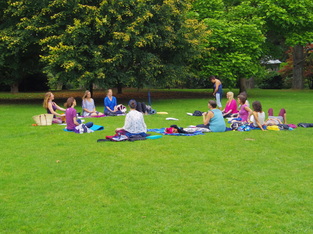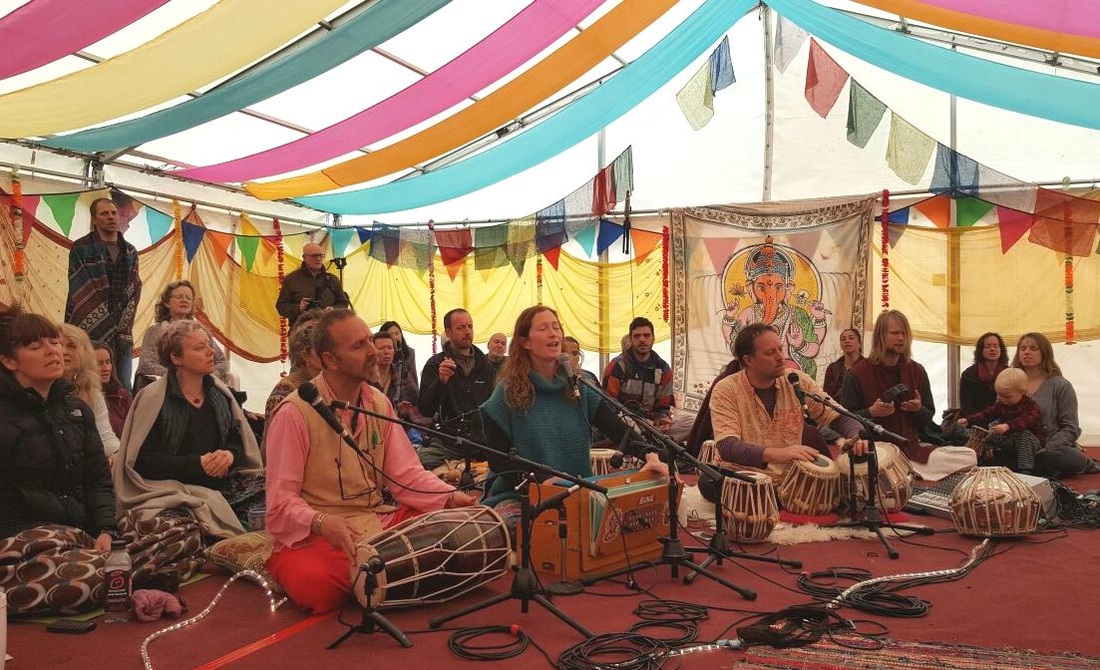 Singing kirtan in Clyne Gardens, Swansea. Fundraiser for First Steps Himalaya. Singing kirtan in Clyne Gardens, Swansea. Fundraiser for First Steps Himalaya. I've realised recently that many people are confused and sometimes put off by the word "chanting" when we refer to kirtan (the singing of devotional songs). There are all sorts of reasons for this reaction, ranging from self consciousness to the feeling that chanting just doesn't sound like much fun, but that's not the subject of this blog. If you need convincing about the joy of kirtan, this article contradicts many of the common misconceptions and describes the increasing popularity of kirtan amongst young westerners: http://www.thetimes.co.uk/article/everybody-chant-now-8h8jrwshq It has become clear to me that what we actually do during kirtan, at least in the kirtans I lead, is closer to what most people would call singing than chanting. By this, I mean that we sing the mantras as melodic devotional songs, rather than in the formal style of Vedic chanting, which may be what people more readily associate with the word chanting. You can sample some meditative Vedic chanting here: https://www.youtube.com/watch?v=hjduAAvCD8E Compare it to the mantra I've shared below to experience how different Vedic chanting is from the bhajans (devotional songs) we sing during kirtan. This is a clip of one of the mantras we regularly sing in my Swansea kirtans: https://soundcloud.com/louise-thorndycraft-blue-sky-yoga/jaya-hanuman-clip The remaining tracks from my CD are also on Soundcloud if you want to hear a wider variety of the mantras we sing at kirtan in Swansea. Traditionally, kirtan in India is practiced using the call and response technique, where the leader or "kirtan wallah" sings one line, then pauses and listens while everyone else sings the line back to him/ her. Practiced this way, kirtan doesn't include harmonies, as everyone is either silent and listening or they are singing the same thing at the same time. In contrast, the way we sing in the kirtans I lead and the technique now used by many western Bhaktas (devotional yogis) is that of singing together. In this case, the leader begins the chant and as soon as everyone else has the hang of it, they join in straight away. This approach opens up the possibility of harmonies emerging, as the mantra is repeated over and over again and people begin to relax and explore the freedom of the voice. Whilst this is not necessarily a traditional approach to singing kirtan, it is something that the western ear is very familiar with. It is also something that the western heart can be deeply moved by. As kirtan is designed to draw out the Bhav, or attitude of spiritual feeling and devotion, in the singer and the listener, I believe that singing together in harmony is a powerful way of accessing this space of deep feeling. As part of the path of Bhakti yoga, union with Oneness/ Self/ Divinity through devotion and surrender, kirtans which touch the heart and encourage the flowering of a deeper, more expansive love are what help us to realise this union. We simultaneously unite with our deepest Self and with all who share the joyful practice of singing the Divine names together. Technically, we are "chanting" mantras, regardless of which way we do it. The Sanskrit mantras used in both kirtan and Vedic chanting have a particular sound vibration and they embody this vibration whether they are sung as devotional songs or chanted as meditative mantras. However, for the purpose of clear communication, particularly with people who are new to kirtan, I feel the word singing is probably more helpful in describing the practice. What do you think?
2 Comments
Really good blog Lou, and an interesting question. In our Kirtan sessions we tend to talk about both singing and chanting of the mantras, I don't think it really matters too much what labels we use.
Reply
Graham Matthews
17/9/2016 12:09:49 pm
Hari AUM Louise I found this really helpful as I am new to Kirtan. Also Jim's comments were helpful.
Reply
Your comment will be posted after it is approved.
Leave a Reply. |
Lessons from Mother NatureLouise Thorndycraft's blog - sharing thoughts about this multi-faceted life and its many lessons.... Archives
March 2020
Categories
All
|

 RSS Feed
RSS Feed
